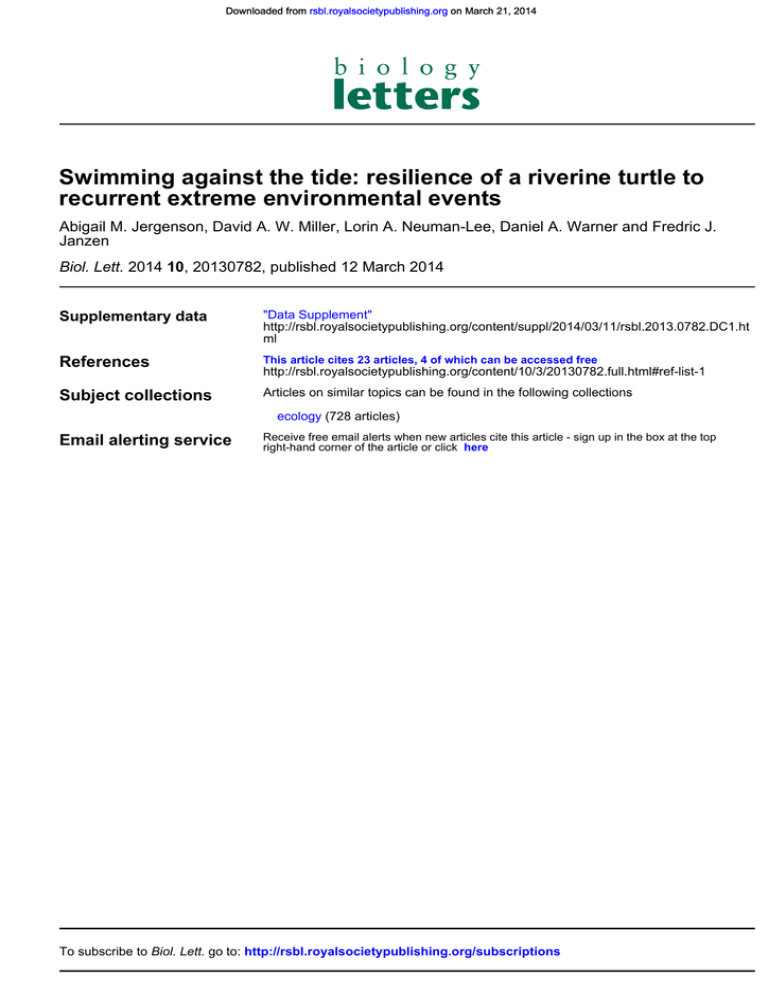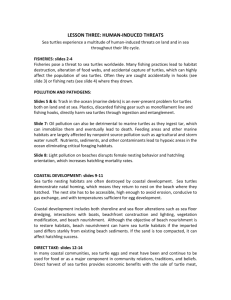
Downloaded from rsbl.royalsocietypublishing.org on March 21, 2014
Swimming against the tide: resilience of a riverine turtle to
recurrent extreme environmental events
Abigail M. Jergenson, David A. W. Miller, Lorin A. Neuman-Lee, Daniel A. Warner and Fredric J.
Janzen
Biol. Lett. 2014 10, 20130782, published 12 March 2014
Supplementary data
"Data Supplement"
http://rsbl.royalsocietypublishing.org/content/suppl/2014/03/11/rsbl.2013.0782.DC1.ht
ml
References
This article cites 23 articles, 4 of which can be accessed free
Subject collections
Articles on similar topics can be found in the following collections
http://rsbl.royalsocietypublishing.org/content/10/3/20130782.full.html#ref-list-1
ecology (728 articles)
Email alerting service
Receive free email alerts when new articles cite this article - sign up in the box at the top
right-hand corner of the article or click here
To subscribe to Biol. Lett. go to: http://rsbl.royalsocietypublishing.org/subscriptions
Downloaded from rsbl.royalsocietypublishing.org on March 21, 2014
Global change biology
rsbl.royalsocietypublishing.org
Research
Cite this article: Jergenson AM, Miller DAW,
Neuman-Lee LA, Warner DA, Janzen FJ. 2014
Swimming against the tide: resilience
of a riverine turtle to recurrent extreme
environmental events. Biol. Lett. 10: 20130782.
http://dx.doi.org/10.1098/rsbl.2013.0782
Received: 7 September 2013
Accepted: 13 February 2014
Swimming against the tide: resilience
of a riverine turtle to recurrent extreme
environmental events
Abigail M. Jergenson1, David A. W. Miller2, Lorin A. Neuman-Lee3,
Daniel A. Warner4 and Fredric J. Janzen1
1
Department of
Department of
PA 16802, USA
3
Department of
4
Department of
2
Ecology, Evolution, and Organismal Biology, Iowa State University, Ames, IA 50011, USA
Ecosystem Science and Management, Pennsylvania State University, University Park,
Biology, Utah State University, Logan, UT 84322, USA
Biology, University of Alabama at Birmingham, AL 35294, USA
Extreme environmental events (EEEs) are likely to exert deleterious effects on
populations. From 1996 to 2012 we studied the nesting dynamics of a riverine
population of painted turtles (Chrysemys picta) that experienced seven years
with significantly definable spring floods. We used capture–mark–recapture
methods to estimate the relationships between more than 5 m and more than
6 m flood events and population parameters. Contrary to expectations, flooding was not associated with annual differences in survival, recruitment or
annual population growth rates of the adult female segment of the population.
These findings suggest that female C. picta exhibit resiliency to key EEE, which
are expected to increase in frequency under climate change.
Subject Areas:
ecology
Keywords:
turtles, population alteration, climate change,
floods, Chrysemys picta
Author for correspondence:
Fredric J. Janzen
e-mail: fjanzen@iastate.edu
1. Introduction
Extreme environmental events (EEEs), including major floods, droughts, fires and
hurricanes, are expected to increase in frequency with climate change [1]. Such EEE
can unpredictably impact populations of many organisms [2]. Biological responses
to past EEE range from transient (e.g. loss of three-quarters of the bird population
during a 10 week period of severe cold and persistent snow cover in England
during 1962–1963; [3]) to persistent (e.g. extirpation of some desert plant populations in response to a severe, four year drought; [4]). Recent studies notably
have indicated persistent alterations in amphibian and reptile populations—
many already imperilled by anthropogenic activities—purportedly owing to
climate change [5,6].
Although EEE are predicted to increase in frequency with climate change
[1], in most scenarios they cannot be anticipated. Thus, assessing the biological
impacts of EEE typically requires fortuitous information collected on populations during or after such events [2]. Moreover, although most studies that
assess the effects of single EEE provide insightful information, repeated
events should provide the most robust assessment of the impacts of EEE on
population biology. Long-term field studies during which multiple EEE have
occurred are one source that can provide this critical information.
We have marked painted turtles (Chrysemys picta) at a study site along the
Mississippi River beginning in 1995. Since then, seven EEE (i.e. major floods)
have been documented, and increased frequency of substantial flooding in
this region is expected under climate change [7]. Painted turtles typically inhabit still wetlands and thus would rarely experience the dramatic flow rates of
floods (figure 1), which can damage biota and habitat considerably [9].
Although adult females are generally philopatric [10], we hypothesized that
EEE would alter the population of C. picta. Specifically, we predicted that a
& 2014 The Author(s) Published by the Royal Society. All rights reserved.
7 × 106
2
7
6 × 106
6
5 × 106
5
4 × 106
4
3 × 106
3
2
2 × 106
1
1 × 106
flow rate (l s–1)
8
rsbl.royalsocietypublishing.org
water level (m)
Downloaded from rsbl.royalsocietypublishing.org on March 21, 2014
0
0
1998
2000
2002
2004
year
2006
2008
2010
2012
Figure 1. Water level and flow rate of the Mississippi River at the study site, 1996 –2012. Water level (solid line) is the maximum height reached during 1 March to
31 May. Flow rate (dotted line) is the average measured during a flood event or the average during April and May in non-flood years. The horizontal line represents
the water level at flooding (5 m) in this area [8].
flood occurring just before the crucial nesting season would
yield fewer marked turtles returning to nest at this site because
many would be swept downstream. We also predicted an
increase of ‘new’ or unmarked (non-primiparous) turtles
at the site because many non-resident turtles would be
swept into the population from upstream. In other words, we
hypothesized that we would observe lower survival, recruitment and lambda in years with flooding, if these EEE exert
immediate negative effects. Falsification of these hypotheses
would suggest that these turtles exhibit substantial resiliency
to such EEE.
2. Material and methods
(a) Field methods
We collected nesting data on C. picta from late May to late June in
1995 – 2012 at the Thomson Causeway in Thomson, IL, USA [11].
During this period, seven years (1996– 1998, 2001, 2002, 2008,
2011) experienced significantly definable spring floods (any
time from 1 March to 31 May; figure 1). A significant flood in
that area is defined as water level more than 5 m [8]. We captured
C. picta on the main beach after nesting to assess whether they
were already marked or, if unmarked, whether they were primiparous or new to the population [11]. We uniquely marked
all unmarked turtles that we captured by filing notches into
different combinations of marginal scutes [12].
(b) Data analyses
We analysed capture– mark – recapture records for nesting turtles
using a reverse-time estimator [13] in the program MARK [14]. We
used this approach to estimate four parameters: annual survival,
recruitment (the annual per capita rate of new individuals entering the population), lambda (the annual growth rate for the
adult female segment of the population) and detection (the probability that an adult female was captured given that she was still
alive). The analyses included hyper-parameters to account for
inter-dependence among individuals within a year [15,16]. We
estimated effects for survival and detection using a logit-link
function, and for recruitment and lambda using a log-link function. Hence, parameter values were on these scales, and credible
intervals for flood effects were used to make inferences.
We performed analyses in the program MARK using two
classes of flooding. In the first analysis, flood events were indicated when water level was more than or equal to 5 m. The
second analysis considered extreme flooding events as water
level more than or equal to 6 m. To evaluate long-term changes
in spring flood incidence, we used x 2 tests to compare the frequencies of flood events during our study period (1996– 2012) to those
during the previous 57 years at our study site. All water level data
were collected approximately 1 km from our study site [8].
3. Results
From 1995 to 2012, we captured an average of 168 unique
nesting painted turtles each year (range ¼ 80–301) of which
an average of 118 were recaptures of previously marked animals (range ¼ 28 –205). The long time period of this study
and large samples provided a rich dataset for assessing
annual patterns in nesting biology.
Spring floods, which always began in April, lasted 3–35
days. Onset of the nesting season was delayed 11 days on
average in flood years, and any turtles swept downriver
had 59 days on average to return to the field site to nest
before the season ended on 30 June.
Credible intervals for the effects of flooding on all parameters widely overlapped 0. In the case of survival and
lambda for both flood levels and of recruitment for the 5 m
flood level, the mean posterior values for a flood effect were,
in fact, positive (table 1). The nesting population generally
increased during the study, with lambda more than 1 in 12 of
the years and overall high survival and consistent recruitment
(figure 2). The only episode of steady decline occurred between
2003 and 2008, a time during which no extreme flooding events
were observed.
During the 16 year study period, our site experienced four
extreme spring flooding events (25%), whereas only eight
extreme spring floods occurred during the previous 57 years
(14%). Although this result suggests an increase in the frequency of extreme floods over time, these patterns did not
differ significantly (x 2 ¼ 1.59, p ¼ 0.207). Less extreme floods
also did not occur more frequently in recent years than in the
past (x 2 ¼ 0.25, p ¼ 0.621).
4. Discussion
Our long-term field study reveals a notable resiliency of adult
female painted turtles to EEE. The population of nesting turtles
was repeatedly unchanged even after major floods just prior to
the nesting season. As aquatic displacement of adult female
painted turtles more than 3 km reduces successful homing behaviour by more than 75% [10], our results suggest that most
Biol. Lett. 10: 20130782
1996
Downloaded from rsbl.royalsocietypublishing.org on March 21, 2014
(a) 1.0
+
+
*
(b) 0.5
+
0.4
recruitment
survival
0.9
0.8
0.7
+
0.2
0.0
1996 1998 2000 2002 2004 2006 2008 2010 2012
1996 1998 2000 2002 2004 2006 2008 2010 2012
year
year
(d ) 0.8
+ *
*
+
+ *
0.7
*
0.6
1.1
*
+
+
detection
lambda
0.3
Biol. Lett. 10: 20130782
1.3
+
+ *
0.1
0.6
(c) 1.5
3
+ *
*
rsbl.royalsocietypublishing.org
*
+ *
+
+
*
0.5
+
0.4
0.9
0.3
0.7
0.2
1996 1998 2000 2002 2004 2006 2008 2010 2012
1995
1998
2001
year
2004
2007
2010
year
Figure 2. Annual estimates of survival, recruitment, lambda and detection for a riverine population of adult female painted turtles, 1995 – 2012. Plotted results
represent mean posterior values and 95% credible intervals obtained from a model in which 5 m flooding was included as an effect. Years with flooding more than
5 m (but less than 6 m) are denoted by *, and those with more than 6 m by þ.
Table 1. Estimates of parameters for a riverine population of adult female painted turtles in the context of definable spring flood events, 1995– 2012. Data
were analysed using reverse-time capture– mark – recapture estimators fit using MCMC methods. Effects for survival and detection are on a logit scale and for
recruitment and lambda are on a log scale. Positive estimates indicate that the parameter was greater in flood years than in non-flood years.
more than 5-m flood
parameter
estimate
more than 6-m flood
LCI
UCI
estimate
LCI
UCI
survival
0.35
20.37
1.09
0.37
20.72
1.40
recruitment
lambda
0.34
0.14
20.13
20.16
0.76
0.26
20.04
0.08
21.04
20.14
1.15
0.12
20.08
20.49
0.33
20.22
20.63
0.13
detection
turtles probably took refuge in low-current locations during
floods to avoid substantive displacement.
Aquatic turtles appear resilient in harsh environments [17]. Although events, for example freezing [18], can
induce significant mortality, the iconic individual longevity
of turtles could help buffer their populations from adverse
effects of such EEE [19]. Since first appearing in the Triassic,
turtles as a lineage have repeatedly survived numerous
global cataclysms, yet most extant turtle species appear on
the IUCN Red List [20] and EEE are expected to increase in
frequency with climate change [7], which will challenge
their historical resiliency.
This study addresses the influence of a particular short-lived
EEE—flooding—and may not reflect the biological impact of
another type of EEE on these or other turtle populations. For
example, extreme heat can reduce hatching success and fully
skew offspring sex ratio [21], which subsequently impact population size and structure [11]. In addition, flooding events
during other times of the year (e.g. egg-incubation season) dramatically affect population recruitment [21,22] by reducing egg
survival. The work reported here is observational and we do not
know how these floods affect juveniles and males, energy
expenditure during increased flow rates, turtle predators and
prey, or organisms that are not as well adapted to an aquatic
environment. Nevertheless, the multiple spring flooding
events that occurred during our long-term study provided a
rare and unmatched opportunity to rigorously evaluate how
this EEE might contribute to population dynamics. Indeed,
other types of major weather events can substantially affect
migration in other taxa [23].
Downloaded from rsbl.royalsocietypublishing.org on March 21, 2014
We thank the Iowa State University Committee on Animal Care for
permission to study the turtles.
Acknowledgement. We thank the Janzen Lab and Turtle Camp crews
who gathered these data over the past two decades. We also thank
the U.S. Army Corps of Engineers and Illinois Department of Natural
Resources for permission to work at the field site.
Data accessibility. Data deposited in Dryad: http://dx.doi.org/10.5061/
dryad.64380
Funding statement. The research was financially supported by NSF
LTREB grant nos. DEB-0089680 and DEB-0640932.
1.
2.
3.
4.
5.
6.
7.
8.
9.
Rahmstorf S, Coumou D. 2011 Increase of extreme
events in a warming world. Proc. Natl Acad. Sci. USA
108, 17 905–17 909. (doi:10.1073/pnas.
1101766108)
Doak DF et al. 2008 Understanding and predicting
ecological dynamics: are major surprises inevitable?
Ecology 89, 952–961. (doi:10.1890/07-0965.1)
Cawthorne RA, Marchant JH. 1980 The effects
of the severe winter 1978/79 on British bird
populations. Bird Study 27, 163–172. (doi:10.1080/
00063658009476675)
McAuliffe JR, Hamerlynck EP. 2010 Perennial plant
mortality in the Sonoran and Mojave deserts in
response to sever, multi-year drought. J. Arid
Environ. 74, 885 –896. (doi:10.1016/j.jaridenv.
2010.01.001)
Gibbons JW et al. 2000 The global decline of
reptiles, déjà vu amphibians. BioScience 50,
653–666. (doi:10.1641/0006-3568(2000)050[0653:
TGDORD]2.0.CO;2)
Collins JP, Storfer A. 2003 Global amphibian
declines: sorting the hypotheses. Divers. Distrib. 9,
89 –98. (doi:10.1046/j.1472-4642.2003.00012.x)
Jha M, Pan Z, Takle ES, Gu R. 2004 Impact of
climate change on stream flow in the Upper
Mississippi River Basin: a regional climate model
perspective. J. Geophys. Res. 109, D09105. (doi:10.
1029/2003JD003686)
US Army Corps of Engineer. 2012 Mississippi river at
Lock and Dam 13: pool level in feet (data file). See
http://www2.mvr.usace.army.mil/WaterControl/
stationinfo2.cfm?sid=FLTI2&fid=FLTI2&dt=S.
Poff NL, Allan JD, Bain MB, Karr JR, Prestegaard KL,
Richter BD, Sparks RE, Stromberg JC. 1997 The
10.
11.
12.
13.
14.
15.
16.
natural flow regime. BioScience 47, 769–784.
(doi:10.2307/1313099)
Ernst CH. 1970 Homing ability in the painted turtle,
Chrysemys picta (Schneider). Herpetologica 26,
399 –403.
Schwanz LE, Spencer R-J, Bowden RM, Janzen FJ.
2010 Climate and predation dominate juvenile and
adult recruitment in a turtle with temperaturedependent sex determination. Ecology 91,
3016 –3026. (doi:10.1890/09-1149.1)
Bowen KD, Janzen FJ. 2008 Human recreation
and the nesting ecology of a freshwater turtle
(Chrysemys picta). Chel. Conserv. Biol. 7, 95 –100.
(doi:10.2744/CCB-0650.1)
Pradel R. 1996 Utilization of capture–mark –
recapture for the study of recruitment and
population growth rate. Biometrics 52, 703 –709.
(doi:10.2307/2532908)
White GC, Burnham KP. 1999 Program MARK:
survival estimation from populations of marked
animals. Bird Study 46, S120–S139. (doi:10.1080/
00063659909477239)
Lukacs PM et al. 2008 Separating components of
variation in survival of mule deer in Colorado.
J. Wildl. Manage. 73, 817–826. (doi:10.2193/
2008-480)
White GC, Burnham KP, Barker RJ. 2008 Evaluation
of Bayesian MCMC random effects inference
methodology for capture-mark-recapture data. In
Modeling demographic processes in marked
populations: environmental and ecological statistics
series, vol. 3 (eds DL Thompson, EG Cooch,
MJ Conroy), pp. 1119–1127. New York, NY:
Springer.
17. Frazer NB, Gibbons JW, Greene JL. 1990 Growth,
survivorship, and longevity of painted turtles
Chrysemys picta in a southwestern Michigan marsh.
Am. Midl. Nat. 125, 245–258. (doi:10.2307/
2426229)
18. Costanzo JP, Lee Jr RE, Ultsch GR. 2008 Physiological
ecology of overwintering in hatchling turtles. J. Exp.
Zool. 309A, 297–379. (doi:10.1002/jez.460)
19. Morris WF et al. 2008 Longevity can buffer plant
and animal populations against changing climatic
variability. Ecology 89, 19 –25. (doi:10.1890/070774.1)
20. [IUCN] International Union for Conservation of
Nature. 2008 IUCN Red List of Threatened Species.
See www.iucnredlist.org.
21. Janzen FJ. 1994 Climate change and temperaturedependent sex determination in reptiles. Proc. Natl
Acad. Sci. USA 91, 7487–7490. (doi:10.1073/pnas.
91.16.7487)
22. Ernst CH. 1974 Effects of Hurricane Agnes on a
painted turtle population. J. Herpetol. 8, 237 –240.
(doi:10.2307/1563169)
23. Censky EJ, Hodge K, Dudley J. 1998 Over-water
dispersal of lizards due to hurricanes. Nature 395,
556. (doi:10.1038/26886)
24. Fordham DA, Georges A, Brook BW. 2009
Experimental evidence for density-dependent
responses to mortality of snake-necked turtles.
Oecologia 159, 271–281. (doi:10.1007/s00442-0081217-5)
25. Spencer R-J, Janzen FJ. 2010 Demographic
consequences of adaptive growth and the
ramifications for conservation of long-lived
organisms. Biol. Conserv. 143, 1950–1959.
Biol. Lett. 10: 20130782
References
4
rsbl.royalsocietypublishing.org
Our findings offer hope that chelonians may be more resistant to at least some environmental and anthropogenic changes
than traditionally feared. A growing body of research suggests
that many turtle populations may express phenotypic plasticity
or heritable variation in particular traits that permits coexistence
with a range of human activities in altered environments
[12,24,25]. Even so, no population can endure when habitats
are rapidly and thoroughly destroyed, which is perhaps the gravest threat to the long-term persistence of these venerable
creatures and other organisms.








